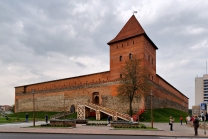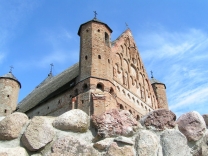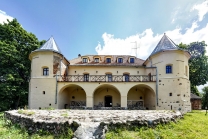Mir Castle Complex
No video yet

Mir Castle Complex
The Mir Castle Complex (Belarusian: Мірскі замак, Łacinka: Mirski zamak, Lithuanian: Myriaus pilis, Polish: Zamek w Mirze) is a UNESCO World Heritage site in Belarus. It is in the town of Mir, in the Kareličy District of the Hrodna voblast, at 53°27′4.46″N 26°28′22.80″E / 53.4512389°N 26.4730000°E / 53.4512389; 26.4730000, 29 kilometres (18 mi) north-west of another World Heritage site, Niasviž Castle. Mir Castle Complex is 164 metres (538 ft) above sea level.
From 1921 to 1939 the castle belonged to the territory of Poland.
History
Duke Juryj Ivanavič Illinič (pl:Jerzy Iwanowicz Ilinicz) began construction of the castle near the village of Mir after the turn of the 16th century in the Polish Gothic style. Five towers surrounded the courtyard of the citadel, the walls of which formed a square of 75 metres (246 ft) on each side. In 1568, when the Ilyinich dynasty died out, the Mir Castle passed into the hands of Mikołaj Krzysztof "the Orphan" Radziwiłł, who refitted it with a two-winged, three-story stately residence along the eastern and northern inner walls of the castle. Plastered facades were decorated with limestone portals, plates, balconies and porches in the Renaissance style.
Drawing by Napoleon Orda, 1876In 1817, after the castle had been abandoned for nearly a century and had suffered severe damage in the Battle of Mir (1812), owner Dominik Hieronim Radziwiłł died of battle injuries and the castle passed to his daughter Stefania, who married Ludwig zu Sayn-Wittgenstein-Berleburg. Later the castle became a possession of their daughter Maria, who married Prince Chlodwig Hohenlohe-Schillingsfürst.
Their son, Maurice Hohenlohe-Schillingsfürst, sold the castle to Mikalaj Sviatapolk-Mirski, of the Bialynia clan, in 1895. Nikolai's son Michael began to rebuild the castle according to the plans of architect Teodor Bursze. The Sviatapolk-Mirski family owned the castle until 1939, when the Soviet Union occupied eastern Poland.
When German forces invaded the Soviet Union in 1941, they occupied the castle and converted it to a ghetto for the local Jewish population,...









